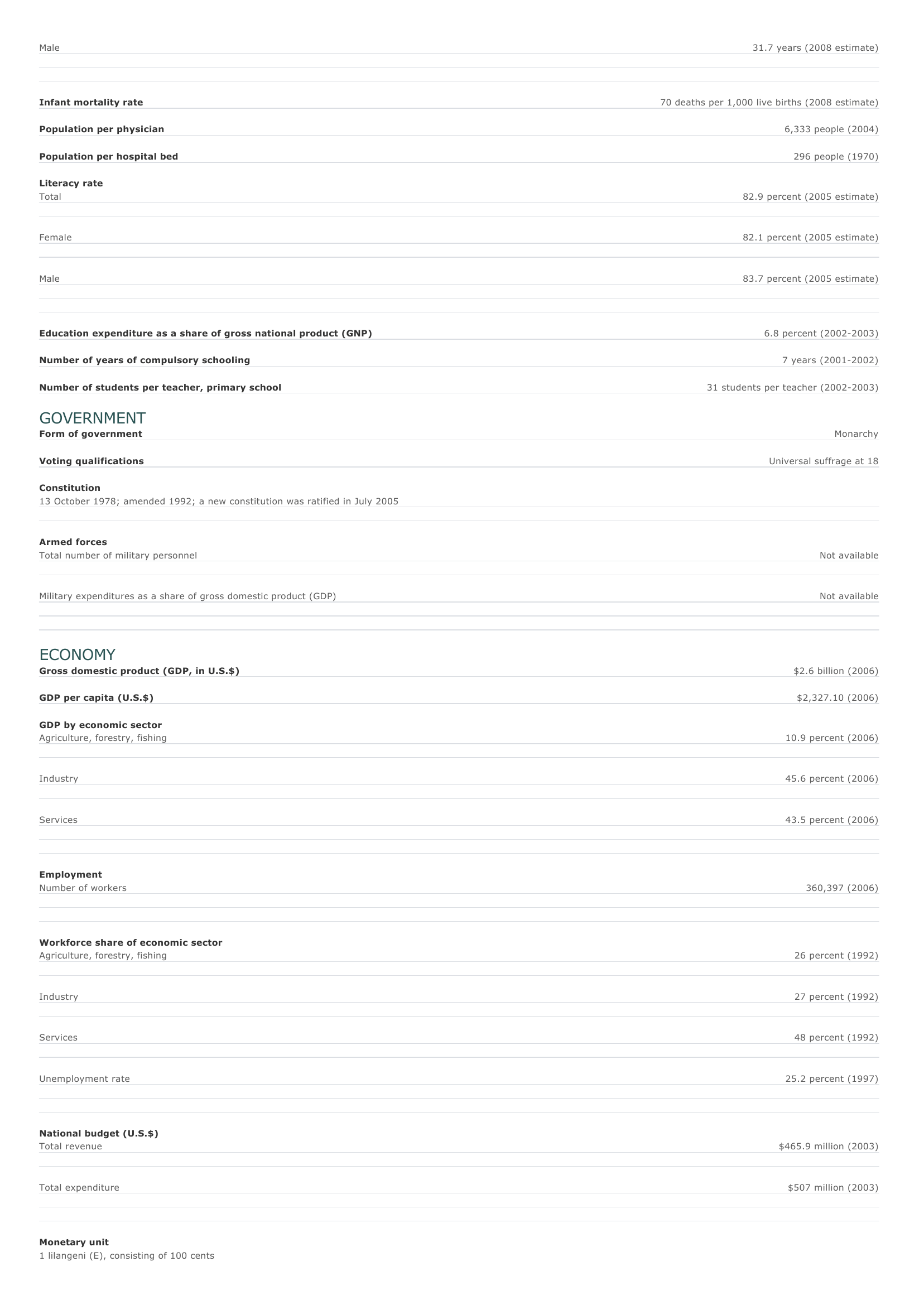Swaziland Facts and Figures. BASIC FACTS Official name Capital Area Kingdom of Swaziland Mbabane 17,363 sq km 6,704 sq mi PEOPLE Population 1,128,814 (2008 estimate) Population growth Population growth rate -0.41 percent (2008 estimate) Projected population in 2025 1,008,990 (2025 estimate) Projected population in 2050 751,328 (2050 estimate) Population density 66 persons per sq km (2008 estimate) 170 persons per sq mi (2008 estimate) Urban/rural distribution Share urban 23 percent (2003 estimate) Share rural 77 percent (2003 estimate) Largest cities, with population Manzini Mbabane Ethnic groups Swazi European, Zulu, Tsonga, Asian 100,833 (2003 estimate) 70,000 (2003 estimate) 97 percent 3 percent Languages English (official), siSwati (official) Religious affiliations Christian 86 percent Protestant 45 percent Roman Catholic 5 percent Other Christians 36 percent Indigenous beliefs 11 percent O ther 3 percent HEALTH AND EDUCATION Life expectancy Total Female 32 years (2008 estimate) 32.3 years (2008 estimate) Male Infant mortality rate Population per physician Population per hospital bed 31.7 years (2008 estimate) 70 deaths per 1,000 live births (2008 estimate) 6,333 people (2004) 296 people (1970) Literacy rate Total 82.9 percent (2005 estimate) Female 82.1 percent (2005 estimate) Male 83.7 percent (2005 estimate) Education expenditure as a share of gross national product (GNP) Number of years of compulsory schooling Number of students per teacher, primary school 6.8 percent (2002-2003) 7 years (2001-2002) 31 students per teacher (2002-2003) GOVERNMENT Form of government Monarchy Voting qualifications Universal suffrage at 18 Constitution 13 October 1978; amended 1992; a new constitution was ratified in July 2005 Armed forces Total number of military personnel Not available Military expenditures as a share of gross domestic product (GDP) Not available ECONOMY Gross domestic product (GDP, in U.S.$) GDP per capita (U.S.$) $2.6 billion (2006) $2,327.10 (2006) GDP by economic sector Agriculture, forestry, fishing 10.9 percent (2006) I ndustry 45.6 percent (2006) Services 43.5 percent (2006) Employment Number of workers 360,397 (2006) Workforce share of economic sector Agriculture, forestry, fishing 26 percent (1992) I ndustry 27 percent (1992) Services 48 percent (1992) Unemployment rate National budget (U.S.$) Total revenue Total expenditure Monetary unit 1 lilangeni (E), consisting of 100 cents 25.2 percent (1997) $465.9 million (2003) $507 million (2003) Major trade partners for exports South Africa and United Kingdom Major trade partners for imports South Africa, United Kingdom, Netherlands, Switzerland, and France ENERGY, COMMUNICATIONS, AND TRANSPORTATION Electricity production Electricity from thermal sources 51.53 percent (2003 estimate) Electricity from hydroelectric sources 48.47 percent (2003 estimate) Electricity from nuclear sources 0 percent (2003 estimate) Electricity from geothermal, solar, and wind sources 0 percent (2003 estimate) Number of radios per 1,000 people 168 (1997) Number of telephones per 1,000 people 31 (2005) Number of televisions per 1,000 people 120 (2000 estimate) Number of Internet hosts per 10,000 people 13 (2003) Daily newspaper circulation per 1,000 people 27 (1996) Number of motor vehicles per 1,000 people 83 (2003) Paved road as a share of total roads 28 percent (1998) SOURCES Basic Facts and People sections Area data are from the statistical bureaus of individual countries. Population, population growth rate, and population projections are from the United States Census Bureau, International Programs Center, International Data Base (IDB) (www.census.gov). Urban and rural population data are from the Food and Agriculture Organization (FAO) of the United Nations (UN), FAOSTAT database (www.fao.org). Largest cities population data and political divisions data are from the statistical bureaus of individual countries. Ethnic divisions and religion data are largely from the latest Central Intelligence Agency (CIA) World Factbook and from various country censuses and reports. Language data are largely from the Ethnologue, Languages of the World, Summer Institute of Linguistics International (www.sil.org). Health and Education section Life expectancy and infant mortality data are from the United States Census Bureau, International Programs Center, International database (IDB) (www.census.gov). Population per physician and population per hospital bed data are from the World Health Organization (WHO) (www.who.int). Education data are from the United Nations Educational, Scientific and Cultural Organization (UNESCO) database (www.unesco.org). Government section Government, independence, legislature, constitution, highest court, and voting qualifications data are largely from various government Web sites, the latest Europa World Yearbook, and the latest Central Intelligence Agency (CIA) World Factbook. The armed forces data is from Military Balance. Economy section Gross domestic product (GDP), GDP per capita, GDP by economic sectors, employment, and national budget data are from the World Bank database (www.worldbank.org). Monetary unit, agriculture, mining, manufacturing, exports, imports, and major trade partner information is from the statistical bureaus of individual countries, latest Europa World Yearbook, and various United Nations and International Monetary Fund (IMF) publications. Energy, Communication, and Transportation section Electricity information is from the Energy Information Administration (EIA) database (www.eia.doe.gov). Radio, telephone, television, and newspaper information is from the United Nations Educational, Scientific and Cultural Organization (UNESCO) database (www.unesco.org). Internet hosts, motor vehicles, and road data are from the World Bank database (www.worldbank.org). Note Figures may not total 100 percent due to rounding. Microsoft ® Encarta ® 2009. © 1993-2008 Microsoft Corporation. All rights reserved.








